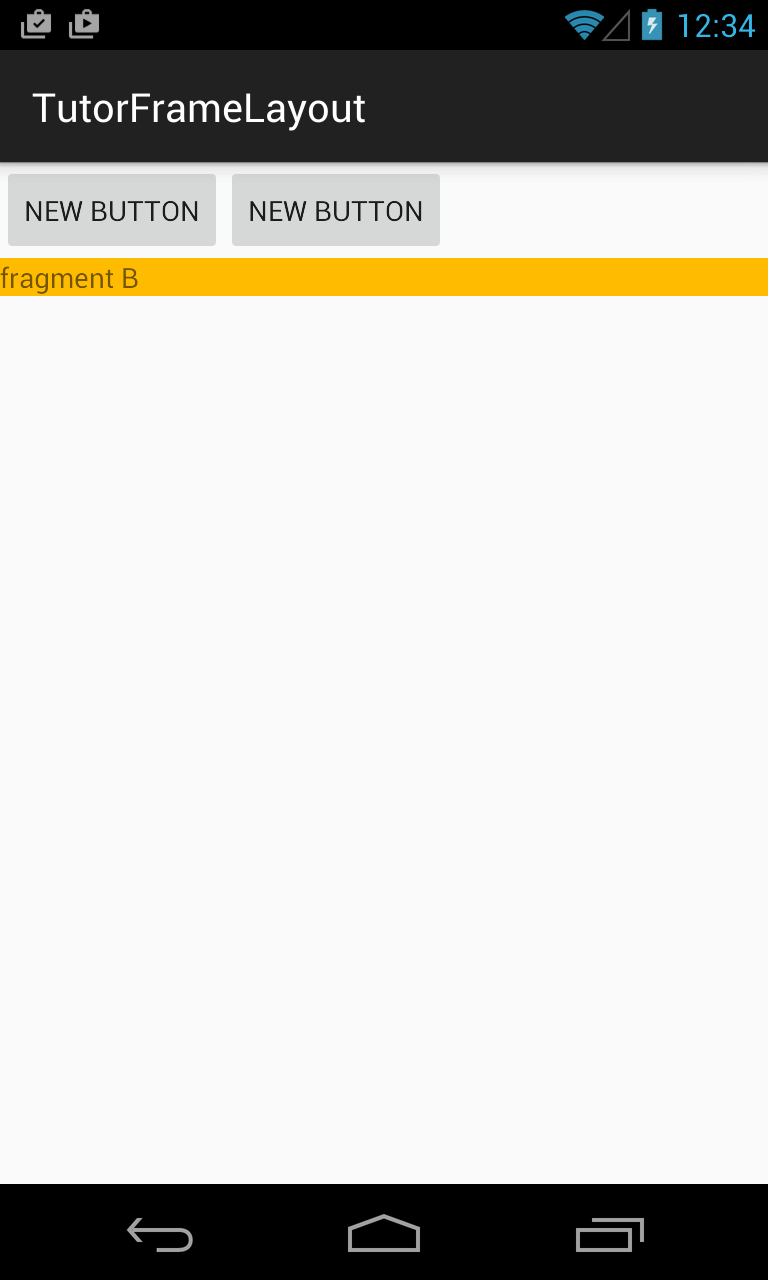Android load two fragments in one FrameLayout base on button click
Example
activity_main.xml
<LinearLayout xmlns:android="http://schemas.android.com/apk/res/android"
xmlns:tools="http://schemas.android.com/tools"
android:layout_width="match_parent"
android:layout_height="wrap_content"
android:orientation="vertical"
tools:context=".MainActivity">
<LinearLayout
android:layout_width="wrap_content"
android:layout_height="match_parent"
android:layout_gravity="left|top"
android:orientation="horizontal">
<Button
android:id="@+id/button2"
android:layout_width="wrap_content"
android:layout_height="wrap_content"
android:onClick="loadFragmentOne"
android:text="New Button" />
<Button
android:id="@+id/button3"
android:layout_width="wrap_content"
android:layout_height="wrap_content"
android:onClick="loadFragmentTwo"
android:text="New Button" />
</LinearLayout>
<FrameLayout
android:id="@+id/mainFrame"
android:layout_width="match_parent"
android:layout_height="match_parent"
android:layout_gravity="right|top" />
</LinearLayout>
MainActivity.java
package com.example.tutorframelayout;
import android.os.Bundle;
import android.support.v4.app.Fragment;
import android.support.v4.app.FragmentManager;
import android.support.v4.app.FragmentTransaction;
import android.support.v7.app.AppCompatActivity;
import android.view.View;
public class MainActivity extends AppCompatActivity {
@Override
protected void onCreate(Bundle savedInstanceState) {
super.onCreate(savedInstanceState);
setContentView(R.layout.activity_main);
}
public void loadFragmentOne(View v) {
FragmentManager fragmentManager = getSupportFragmentManager();
Fragment fragmentA = fragmentManager.findFragmentByTag("frag1");
if (fragmentA == null) {
fragmentA = new FragmentA();
}
FragmentTransaction transaction = fragmentManager.beginTransaction();
transaction.add(R.id.mainFrame, fragmentA, "frag1");
transaction.commit();
}
public void loadFragmentTwo(View v) {
// Replace whatever is in the fragment_container view with this fragment,
// and add the transaction to the back stack so the user can navigate back
FragmentManager fragmentManager = getSupportFragmentManager();
Fragment fragmentB = fragmentManager.findFragmentByTag("frag2");
if (fragmentB == null) {
fragmentB = new FragmentB();
}
FragmentTransaction transaction = fragmentManager.beginTransaction();
transaction.replace(R.id.mainFrame, fragmentB, "frag2");
transaction.setTransition(FragmentTransaction.TRANSIT_FRAGMENT_OPEN); //setting animation for fragment transaction
transaction.addToBackStack(null);
transaction.commit();
}
}
FragmentA.java
package com.example.tutorframelayout;
import android.os.Bundle;
import android.support.annotation.Nullable;
import android.support.v4.app.Fragment;
import android.view.LayoutInflater;
import android.view.View;
import android.view.ViewGroup;
import android.widget.Button;
public class FragmentA extends Fragment {
@Override
public void onCreate(Bundle savedInstanceState) {
super.onCreate(savedInstanceState);
}
@Override
public View onCreateView(LayoutInflater inflater, ViewGroup container, Bundle savedInstanceState) {
return inflater.inflate(R.layout.fragment_a,container,false);
}
@Override
public void onSaveInstanceState(Bundle outState) {
//Saving data while orientation changes
super.onSaveInstanceState(outState);
}
}
fragment_a.xml
<?xml version="1.0" encoding="utf-8"?>
<LinearLayout xmlns:android="http://schemas.android.com/apk/res/android"
android:layout_width="match_parent"
android:layout_height="match_parent"
android:background="#df00f7ff">
<TextView
android:id="@+id/textView"
android:layout_width="wrap_content"
android:layout_height="wrap_content"
android:text="fragment A" />
</LinearLayout>
FragmentB.java
package com.example.tutorframelayout;
import android.os.Bundle;
import android.support.v4.app.Fragment;
import android.view.LayoutInflater;
import android.view.View;
import android.view.ViewGroup;
public class FragmentB extends Fragment {
@Override
public void onCreate(Bundle savedInstanceState) {
super.onCreate(savedInstanceState);
}
@Override
public View onCreateView(LayoutInflater inflater, ViewGroup container, Bundle savedInstanceState) {
return inflater.inflate(R.layout.fragment_b,container,false);
}
@Override
public void onSaveInstanceState(Bundle outState) {
//Saving data while orientation changes
super.onSaveInstanceState(outState);
}
}
fragment_b.xml
<?xml version="1.0" encoding="utf-8"?>
<LinearLayout xmlns:android="http://schemas.android.com/apk/res/android"
android:layout_width="match_parent"
android:layout_height="match_parent"
android:background="#FFBB00">
<TextView
android:id="@+id/textView"
android:layout_width="wrap_content"
android:layout_height="wrap_content"
android:text="fragment B" />
</LinearLayout>
OutPut

